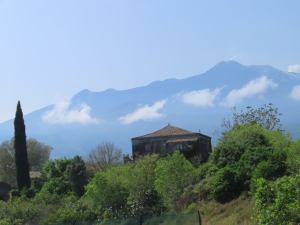
A one € house might be yours.
In Part 2, we explored the historic Valley of the Temples in Agrigento and hiked on Mt. Etna. We also enjoyed sumptuous meals near both those famous landmarks.
We left the island of Sicily for the mainland region of Basilicata, Italy, aboard a 20-minute ferry that docked in Villa San Giovanni, Calabria. Calabria (old Italy) means “place of the bull.” Ninety percent of Calabria is mountainous.
Enroute to Matera, a city of growing fascination the more we learned, we pass by isolated run-down buildings along the road called “one Euro properties.” That’s the price anyone can pay to own one of these crumbling, likely medieval times-built homes. Here’s the backstory. Small villages desperately need restoration of abandoned homes that might entice new residents. However, remaining villagers are likely impoverished and unable to tackle repairs of a second home. Anyone can apply to buy one of those homes for one € with the pledge to restore it to historical accuracy. Applicant must also commit to five – 10 years ownership (depending on the area) but is not required to live there year-round. The property must remain a personal home and cannot be turned into a B&B or other money-making business. Not caring which homes qualified for a one € sale did not stop our 18-member tour group from pointing out luxury homes for the remainder of the two-week trip and yelling out, “One € house.”
We were told on that bus ride something that clashed what my husband, Russ, and I had learned on a Spanish olive and wine farm we’d visited during an Odysseys Unlimited tour to Portugal and Spain.* The owner of that well-regarded farm said most of the olive oil produced in Italy came from imported Spanish olives. This time, as we passed by orchards of olive trees, we were told that 77% of all olive oil produced in southern Italy is from Italian olive trees.
We also saw orchards of the smaller-sized bergamot trees. Calabrian bergamot trees grow citrus fruit on land overlooking the Ionian Sea. I am familiar with bergamot as it’s one of the pleasing fragrances in perfumes I wear that do not “turn” when touching my skin. While most of the Italian-grown bergamot is sent to France to be used for perfumes, I must say it was surprising to learn that a leaf of bergamot is included in the manufacture of Earl Grey tea.
We also learned during the drive that 93% of all Italian licorice comes from Calabria, as does a popular Italian peasant food called Nduja. Nduja is a type of smoked pork sausage andouille akin to Spanish sobrassada. The sausage comes from free-roaming farm pigs that feast on chestnuts from trees blanketing the surrounding hillside.
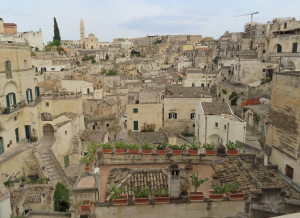
Overlooking the Sassi in Matera.
MATERA
what we learned:
Matera is referred to as the “City of the Sassi.” The city sits on the plateau of la Murgia, not far from the Apulian (also called Puglia) border. Our Odysseys Unlimited tour package described it as an old site where troglodyte churches and dwellings (which did make me wonder at the time why they didn’t say houses) were carved into porous chalky rock. Sassi is Italian for rocks, from which those cave dwellings were carved. Considered one of the world’s oldest inhabited cities, historians think people began cave dwelling there about 7,000 years ago. As little as I knew then about Matera, it turned out to be one of the most fascinating cities I’ve ever visited.
One of the many reasons we love taking an Odysseys Unlimited tour is the knowledgeable, local guides. In Matera we had someone who had lived in the area and was a social worker in 1984 aiding residents who were not adjusting well to being moved from cave dwellings to more modern housing elsewhere. She spoke how people lived in the Sassi until 1956 when the government first pushed to relocate them. Until then, the 30,000 residents existed in 3,000 caves with no water, electricity, privacy, or education. Animals were kept inside for warmth. Every inch of the cave was used.

A museum shows the family living in the cave had no privacy even for bodily functions.
There were two groups living in the caves in their separate area. Neither liked socializing with the other. Workers hired to work fields or in the employ of those who lived “above ground” would often walk hours to jobs. The guide spoke of the resistance government workers faced from those not willing to move, until in 1968, the government forced the issue. Even then, many Sassi were fearful of modern amenities, such as toilets, bathtubs, windows, and doors that closed. She said the government wondered why household plumbing was always plugged up in modern housing until they learned the Sassi didn’t understand the purpose of toilets and bathtubs. They had been storing household belongings or planting their gardens in them.
UNESCO declared Matera a World Heritage site in 1993. In 2019, the city was designated European Capital of Culture. But even with all the advances to modernize and mandating restrictions necessary to continue being funded, the residents still break the rules, such as no parking cars in the narrow streets.
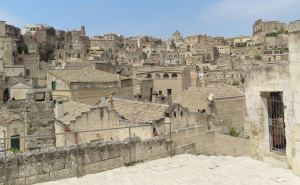
Many Sassi have returned to this UNESCO World Heritage site.
Many former residents and relatives of former residents have returned to the Sassi. They can obtain a lease for 99 years. The government provides 80% funding to renovate caves into B&Bs, but only 50% if used for a private residence. The boutique hotel we stayed at had once been a collection of cave dwellings. The two rooms we occupied at Locanda de San Martino might have once housed up to 13 children, adults, and animals. Residents lived an average age of 40-50, but even by 1968 when the last residents were resettled, there was an 85% mortality rate for infants.
Matera’s preservation is likely why the ancient city has been a backdrop to movies, such as Mel Gibson’s Passion and the opening scenes of the 25th James Bond film, No Time to Die, starring Daniel Craig.
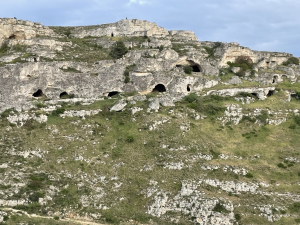
These are where the Sassi lived before their cave dwellings were modernized.
The Sassi (which is the lower depths of Matera, is often called the “city of upside places.” In usual construction scenarios, a person wanting to add another floor to a house builds up. Not in the Sassi. They dug down and outward of the softer rock to create another home, church, or business. Before modernization, there were no burials in a coffin placed in the ground. The stripped-naked body was laid on the floor and covered with stones until it rotted away. The liquids from that putrefied body would seep through the floor to the ceiling below. Not only was there a rank odor, but always the possibility of disease being spread.
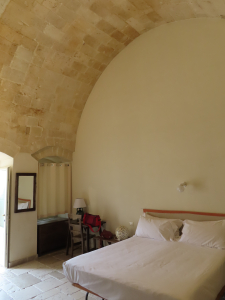
Our room in Locanda de San Martino in the Sassi.
where we stayed:
The 32-room Locanda de San Martino has transformed cave dwellings into individually sized rooms with modern amenities and Sassi inspired décor. An antiqued carved desk hugged the wall opposite our comfy bed. Large wooden hangars in the shape of a stylized cross hung from the doorless closet. A bistro table and two chairs sat just outside the door. The cave’s original walls and ceiling have been curved and smoothed by white plaster. Breakfast was served in a large room off the tiny bar area. Because of COVID safety protocols, a hotel staffer plated and served selections we made from the wide variety of pastries, fruits, meats, and cheeses. Here’s a helpful hint if you go: I had been told to go to the bar to place my coffee order. I had no idea I was violating the process and it did cause a bit of a kerfuffle, so here’s the rule: sit down at a table. Wait for the server to come ask for your order. You will not be acknowledged otherwise. The hotel doesn’t have a kitchen, so all the food is brought to the hotel for each meal. I tell you this because when a food item runs out, that’s all there is until the next day.
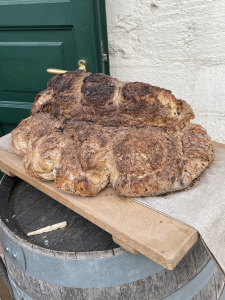
Bread in Matera is oversized but originally fed a family for a week.
where we ate:
When you pass small restaurants tucked into the rocky greyish-white walls of the Sassi, small display tables frequently feature an oversized loaf of bread pretzeled into a round pull-apart lumpy shape. This is the type of bread that has kept Sassi families alive for centuries. Women kneaded the dough, shaped it, and then delivered it to the baker for cooking in a wood-fired oven. Large loaves meant a large family could eat and survive. If any became stale, it was creatively recycled into new dishes. Over time, the dishes made from stale bread became signature to the culture. One of those signature Matera dishes is crapiata, a thick-broth bean soup.
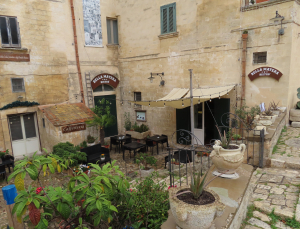
One of many small restaurants in the Sassi.
We stepped down into the cozy confines of Nadi Restaurant in the Sassi, which specializes in traditional Mediterranean fare. The atmosphere was bustling and crowded with sharp aromas of Mediterranean cuisine and the packed tables of diners. Odysseys had pre-planned our multi-courses meal. For appetizer we had fresh ricotta, the famous local bread, two types of vegetable quiche, small cubes of melt-in-your-mouth cauliflower flan, and an assortment of roasted veggies. I’d have happily filled up on these delights but knew more was coming. Our second course was fresh Orecchiette (little ears) pasta shredded with broccoli. The third course was veal rolls that had been steeped in a rich, marinara sauce. And yes, the fourth course was dessert: a ricotta and chocolate cake. We drank a local red wine bearing Nadi’s label. Considering how much we ate and drank, what a blessing this little slice of wonderful food station was practically next door to our hotel.
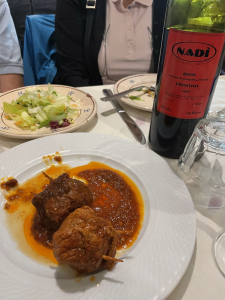
Nadi’s red wine complimented their veal rolls steeped in a rich, marinara sauce.
The next day, after touring the city and visiting a small museum dedicated to showing how the Sassi residents lived before being uprooted, another big dinner was planned. That was still hours away and most of us wanted a light lunch. We sat outside under the awning of Typical Bistrot, a local favorite according to our Tour Director Andrea F. The café’s awning helped a bit for us to escape the sudden blasts of wind gusting through Matera’s main pedestrian thoroughfare. I don’t know if the restaurant has another name because that’s all their signage said, but look for the place with a long queue waiting impatiently. Russ had an open-faced sandwich with fresh ricotta, Italian ham, and large sundried tomatoes. I ordered the crapiata. It came with toasted and buttered slices of bread.
On our final night in Matera, we ate a pre-arranged group meal in a private room at Le Botteghe. We began with family platters of black olives, roasted red pepper slices, bread, fresh ricotta and mozzarella, small flan and quiche squares, prosciutto, and sundried tomatoes. The next course was a dense pasta dish with fried pieces of prosciutto and both sundried and grilled tomatoes. The third course was baked potato halves, pork sausages, and grilled lamb chunks.
Tomorrow, we leave behind the caves of the Sassi and head to Lecce, home of Lecce baroque architecture.
*SPAIN AND PORTUGAL: HOW CENTURIES OF RELIGIOUS BATTLES LED TO ARCHITECTURAL WONDERS, SAVVY CUISINE, FRAGRANT WINES, AND THE HEROICS OF WHICH NOVELS ARE WRITTEN (https://karenkuzsel.com/2017/06/29/part-3-spain-and-portugal-how-centuries-of-religious-battles-led-to-architectural-wonders-savvy-cuisine-fragrant-wines-and-the-heroics-of-which-novels-are-written/).
In Part 4: TRAVELER DISCOVERIES OF SOUTHSIDE ITALY’S ANCIENT ORIGINS, we discover how conical-roofed houses called trulli fooled the King’s taxmen.
https://www.ristorantenadi.com/index.asp
www.locandadisanmartino.it/
https://odysseys-unlimited.com
http://www.lebotteghematera.it/
Karen Kuzsel is a writer-editor based in the Orlando area who specializes in the hospitality, entertainment, meetings & events industries. She is an active member of International Live Events Association and Meeting Professionals International and is now serving on the 2021-2022 MPI Global Advisory Board for Small Business Owners. She is a member of the Society of Professional Journalists. Karen writes about food & wine, spas, destinations, venues, meetings & events. A career journalist, she has owned magazines, written for newspapers, trade publications, radio and TV. As her alter-ego, Natasha, The Psychic Lady, she is a featured entertainer for corporate and social events. Karen@KarenKuzsel.com; www.KarenKuzsel.com; www.ThePsychicLady.com; @karenkuzsel; @thepsychiclady. Food photos for this series by Karen Kuzsel. All other Photos by Russ Wagner, a retired government planner/builder who has a passion for historic architecture, wine, trains, travel and taking photographs.
